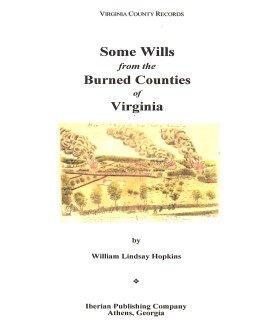 SOME WILLS FROM THE BURNED COUNTIES OF VIRGINIA
compiled by William Lindsay Hopkins. 6x9 format. Wills from circa 1670-1830 for the counties of Brunswick, Buckingham, Caroline, Charles City, Dinwiddie, Elizabeth City,
Gloucester, Hanover, Henrico, James City, King George, King and Queen, King William, Mathews,
Nansemond, New Kent, Prince George, Prince William, Stafford, and Warwick Counties, Va.
SOME WILLS FROM THE BURNED COUNTIES OF VIRGINIA
compiled by William Lindsay Hopkins. 6x9 format. Wills from circa 1670-1830 for the counties of Brunswick, Buckingham, Caroline, Charles City, Dinwiddie, Elizabeth City,
Gloucester, Hanover, Henrico, James City, King George, King and Queen, King William, Mathews,
Nansemond, New Kent, Prince George, Prince William, Stafford, and Warwick Counties, Va.
To view a digital copy of the index to this book, visit Index-Swbc
(Use your back arrow to return to Iberian's catalog)
[Swbc] $32.00 (printed version)
The above title is also available as a digital e-book in PDF format:
[ESwbc] $20.00 (electronic version)
For more records pertaining to HENRICO COUNTY, VIRGINIA see also:





Please see our HELP PAGE for mail-order instructions, wholesaler policies and other contact information.
|| Virginia/W.Va. || General Reference || Military Records ||
|| Other States || E-Books || New Titles || Home Page || E-Books ||
Copyright 2025 Iberian Publishing Company